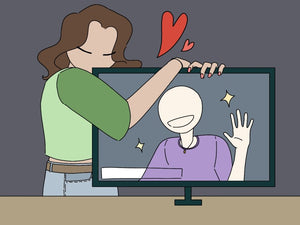Evolutionary Explanations (Relationships Model Answers) (Paper 3 Model Answers)
Outline and briefly discuss the relationship between sexual selection and human reproductive behaviour. ( 8 marks)
Model Answer
Sexual selection plays a significant role in shaping human reproductive behavior by favouring traits that increase reproductive success and ultimately contribute to the passing on of genes. Evolutionary theory suggests that certain traits, such as strength, height, aggression, and wide hips, provide an evolutionary advantage because they enhance an individual's chances of attracting a mate and successfully reproducing. These advantageous traits are more likely to be passed on to future generations, as individuals possessing them are more likely to survive and reproduce.
However, it is important to critically discuss evolutionary explanations of human reproductive behavior. One of the main challenges is the issue of falsifiability, as it can be difficult to empirically test and confirm evolutionary hypotheses in a definitive manner. Additionally, some critics argue that evolutionary explanations can sometimes be considered pseudoscientific due to their reliance on retrospective explanations and the potential for confirmation bias.
As well as this, it is important to look at the relevancy of the approach today. In the past, when women were more dependent on men for resources and protection, traits associated with male resources played a significant role in mate selection. However, societal shifts have led to greater gender equality and women's independence, diminishing the importance of male resources in reproductive decisions. Nowadays, factors like compatibility, emotional connection, and shared values have gained prominence in mate selection. The emphasis on reproductive success has shifted from solely focusing on material resources to encompassing broader considerations that contribute to a satisfying and fulfilling partnership. Therefore, while sexual selection continues to shape human reproductive behavior, its influence has been tempered by societal changes, highlighting the need for a comprehensive understanding of contemporary reproductive dynamics.
Outline an evolutionary explanation for partner preferences. Explain one limitation of an evolutionary explanation for partner preferences. ( 6 marks)
Model Answer
Evolutionary theory provides an explanation for partner preferences based on the goal of maximising reproductive success. According to this perspective, both males and females are driven by intersexual and intrasexual selection. Intersexual selection refers to the preferences and choices made by one sex in selecting a mate from the opposite sex. In this context, females tend to prioritise traits in males that signal good genes, resources, or other qualities that enhance their offspring's chances of survival. On the other hand, males tend to prioritise traits in females that indicate youth, health, and fertility, as these characteristics increase their own reproductive success.
Intrasexual selection involves competition among individuals of the same sex for access to mates. This competition can take various forms, such as physical confrontations, displays of dominance, or demonstrations of social status. The aim is to establish superiority over same-sex rivals and increase the chances of reproductive success by securing access to mates.
However, an important limitation of evolutionary explanations for partner preferences is their difficulty in explaining non-heterosexual relationships. Evolutionary theories predominantly focus on reproduction through heterosexual relationships, assuming that reproductive success is solely dependent on opposite-sex partnerships. This perspective fails to account for the diversity of sexual orientations and the complexities of partner preferences beyond heterosexual norms. It overlooks the social and cultural influences that shape preferences and attractions in individuals who do not conform to traditional reproductive patterns. Consequently, evolutionary explanations have limited applicability when it comes to understanding the partner preferences and relationship dynamics of non-heterosexual individuals.
Discuss evolutionary explanations for partner preferences.
(Total 16 marks)
Model Answer
Evolutionary explanations for partner preferences propose that mate selection is influenced by natural selection, intra-sexual selection, and inter-sexual selection. According to natural selection theory, genes that confer a reproductive advantage will increase in the gene pool over time. Intra-sexual selection refers to the competition among individuals of the same sex, often males, for access to mates. This competition leads to the development of male-female dimorphism, with accentuated secondary sexual characteristics in individuals with greater reproductive fitness. On the other hand, inter-sexual selection involves one sex, usually females, choosing from prospective mates, usually males, based on their attractiveness.
Support for evolutionary explanations comes from studies like Buss's (1989) research on mate choice preferences. Buss surveyed 10,000 adults from 33 countries, inquiring about their ideal partner qualities. The findings indicated that females tended to prioritise resource-based characteristics, such as a good career or financial stability, as these traits signaled the ability to provide for offspring. In contrast, males emphasised physical attractiveness and youth, which are associated with increased fertility and reproductive potential. This study provides empirical support for the role of evolutionary factors in shaping partner preferences.
However, a limitation of evolutionary explanations for partner preferences is their limited applicability to non-heterosexual relationships. Evolutionary theories primarily focus on reproductive success through heterosexual relationships, assuming that reproductive fitness relies solely on opposite-sex partnerships. This perspective fails to account for the diversity of sexual orientations and the complexities of partner preferences beyond traditional reproductive patterns. Non-heterosexual relationships challenge the evolutionary framework, as they are not easily explained by reproductive fitness and the traditional male-female mating dynamics. Consequently, evolutionary explanations may not fully capture the preferences and dynamics observed in non-heterosexual relationships.
Furthermore, it is crucial to consider the relevance of evolutionary explanations for partner preferences in today's context. In the past, when women relied more heavily on men for resources and protection, traits associated with male resources held significant sway in mate selection. However, societal transformations have ushered in greater gender equality and women's independence, diminishing the importance of male resources in reproductive decision-making. Contemporary mate selection factors now encompass compatibility, emotional connection, and shared values, which have gained prominence alongside traditional considerations. The focus has shifted from solely prioritising reproductive success through material resources to embracing broader aspects that contribute to a satisfying and fulfilling partnership. As a result, while sexual selection continues to shape human reproductive behavior, its impact has been moderated by societal changes. This highlights the necessity for a comprehensive understanding of the complex dynamics that characterise modern reproductive choices.
Discuss the relationship between sexual selection and human reproductive behaviour.
(Total 16 marks)
Model Answer
Sexual selection plays a crucial role in shaping human reproductive behavior by influencing mate preferences and behaviors that enhance reproductive success. Inter-sexual selection and intra-sexual selection are two mechanisms that contribute to the relationship between sexual selection and human reproductive behavior.
Inter-sexual selection refers to the selection of mates based on attractive qualities or traits displayed by the opposite sex. This process leads to the development of specific mate preferences. For example, in many societies, females tend to be the selective sex, seeking partners who exhibit traits associated with high genetic quality, good health, resources, or social status. This preference may be rooted in the desire to choose a mate who can provide support and resources for offspring. On the other hand, males may engage in competitive behaviors to attract the attention of potential mates, such as displaying physical prowess or engaging in elaborate courtship rituals.
Intra-sexual selection involves competition among members of the same sex for access to mates. Males, in particular, may exhibit competitive behaviors to secure mating opportunities. These behaviors can include physical aggression, dominance displays, or elaborate courtship rituals. The ultimate goal is to increase their reproductive success by outcompeting rivals and gaining access to desirable partners.
However, it is important to consider the limitations and complexities associated with evolutionary explanations of sexual selection and human reproductive behavior. Firstly, evolutionary explanations tend to focus predominantly on heterosexual relationships, neglecting the experiences and dynamics of individuals with diverse sexual orientations. Human reproductive behavior is not solely driven by biological factors, but also influenced by cultural, social, and individual factors. These factors shape the preferences and choices individuals make in selecting mates, which may extend beyond the scope of evolutionary explanations.
Moreover, the role of sexual selection in contemporary human societies is subject to cultural shifts and societal changes. The emphasis on reproductive success has expanded to encompass broader considerations such as emotional connection, compatibility, and shared values. Factors like social and economic stability, mutual respect, and communication skills have gained prominence in mate selection. This highlights the influence of socio-cultural factors on reproductive behavior and the need to consider the multidimensional nature of human mate preferences.
The issue of falsifiability poses a significant hurdle. Empirically testing and confirming evolutionary hypotheses in a definitive manner can be complex. The nature of human behavior involves a multitude of factors, making it challenging to isolate and measure the precise influence of evolutionary processes. Consequently, it becomes difficult to establish clear cause-and-effect relationships between specific traits and reproductive outcomes, leading to limitations in the strength of supporting evidence.
Finally\, critics argue that evolutionary explanations can sometimes veer into the realm of pseudoscience. Retrospective explanations that attempt to explain current behaviors based on evolutionary advantages can be prone to bias and lack empirical rigor. Confirmation bias, for instance, can lead researchers to selectively focus on evidence that supports their evolutionary hypotheses while neglecting contradictory data. This selective interpretation can undermine the objectivity and reliability of evolutionary explanations and raise concerns about the scientific validity of the approach.
Check out Factors Affecting Attraction Model Answers Here




